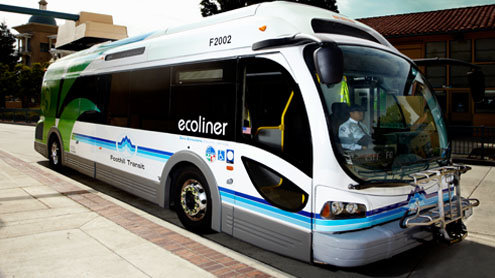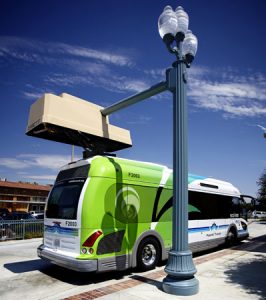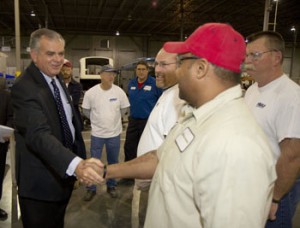
The EcoRide™ BE 35 passes the test in public transit
By Glenn Swain
The acclaimed inventor Thomas Edison once defined electricity as a mode of motion, a description that could just as easily apply to Proterra, Inc, Greenville, SC, a manufacturer of advanced technology for heavy-duty transit buses powered solely by clean domestic fuels and all-electric propulsion.
Formed in 2004, Proterra has been perfecting a battery-powered electric bus that can operate on the same routes as a diesel or CNG bus, and save maintenance repairs and fuel costs. The company’s EcoRide™ BE 35 has been put to the test for a year at Foothill Transit, West Covina, CA. Other buses are planned for San Antonio, TX and Tallahassee, FL.
It has been a rollercoaster year for Proterra. In August, the company moved its headquarters from Golden, CO to Greenville, SC and into the company’s 220,000-square-foot plant. But not before an investor pled guilty in the spring to charges of wire, securities and investment adviser fraud as well as conspiracy, which forced Proterra to search for other funding sources to keep rolling.
Brighter news came in June when the company received $30 million from an investment group led by the Silicon Valley venture capital firm Kleiner, Perkins, Caufield & Byers. The group included GM Ventures, Mitsui & Co., Vision Ridge Partners and 88 Green Ventures.
 “We went through a challenging period that forced us to slow production while we went out and raised additional capital,” says Proterra Chief Business Development Officer Marc Gottschalk. “The investors have given us a lot of strength in terms of not only financial backing but also in experience. This is a game changer for Proterra.”
“We went through a challenging period that forced us to slow production while we went out and raised additional capital,” says Proterra Chief Business Development Officer Marc Gottschalk. “The investors have given us a lot of strength in terms of not only financial backing but also in experience. This is a game changer for Proterra.”
GM Ventures commits to the technology
With the investment money confirmed, Jon Lauckner, president of GM Ventures, referred to the expenditure as his company’s commitment to electric propulsion and the fast-charge technology that will advance the global transportation industry.
GM has taken a direct, hands-on role with Proterra.
“GM Ventures is helping us in a lot of different ways,” Gottschalk says. “Our investors have worked with us on recruitment of new talent and have been working with us on battery technology. They have offered assistance in making sure our manufacturing processes are efficient, and generally stepping up to the plate in a real way to support our company.”
He says GM Ventures’ involvement may be seen as a stamp of approval for the future of rechargeable transit vehicles.
“In some respects we believe GM Ventures jumped on board because of what they could learn from us,” Gottschalk says. “We’re on the cutting edge, and I think GM appreciates that.”
The $30 million influx came months after the company was stung by an investor scandal involving Francisco Illarramendi. The 42-year-old was a majority owner of Stanford, CT-based Michael Kenwood Group LLC, and pled guilty to multiple fraud counts. The Securities and Exchange Commission alleges that Illarramendi took approximately $53 million in investor money out of a hedge fund without the consent of the fund’s investors. Prosecutors called it a Ponzi scheme. Illarramendi awaits sentencing and faces 70 years in prison.
In the aftermath, dozens of workers were laid off at the South Carolina plant and some small suppliers bailed out. In the end, Proterra hung on to the vast majority of its permanent workforce and many customers rallied around the company.
One move put on hold is a proposed new plant planned for Clemson University’s International Center for Automotive Research in Greenville.

“We’ve put off developing the building and will make a decision on that by the end of next year,” Gottschalk says. “We’ve taken on the entire space of the facility we’re in under a three-year lease. We’re remaining flexible. We’re going to see how the demand increases, how quickly we can scale up, and then make a decision when we pull the trigger on a permanent facility.
“There is a change in direction with the new investors, in that we have decided to pour even more resources into engineering, while manufacturing will scale a little bit more slowly. We have a lot of hiring going on right now, and the tip of the spear is in engineering hires.”
In August, moving trucks backed up to the doors of the company’s Golden, CO headquarters, and when fully packed headed east to Greenville.
“As a practical matter for an early-stage company it makes sense for everyone to be in one place,” Gottschalk says.
The EcoRide BE35™
The EcoRide BE35™ contains all-electric components, including an electric drive motor that allows for a quieter ride. Proterra claims that without the maintenance or fuel costs associated with conventional buses, the Proterra BE35™ achieves a 400-percent improvement in fuel economy, and greater than $300,000 savings in total lifetime operating expenses.
For a year three EcoRides have been in regular use by Foothill Transit. Dubbed the “Ecoliner,” Foothill Transit officials put the new buses on a 19-mile, very busy, local line with nearly 60,000 boardings a month. Reports show the Ecoliner is progressing as anticipated, is meeting expectations, and continues to indicate overall energy efficiency.

“The system is designed for a two- to four-hour transit bus cycle, which typically relates to 30 to 40 miles,” says Joshua Goldman, Proterra director of business development. “Over 50 miles has been demonstrated at Foothill.”
Through an upcoming RFP process, Proterra will be bidding for the chance to provide Foothill Transit with more buses. Meanwhile, three EcoRides are slated for delivery to StarMetro in Tallahassee, FL, with an additional three bound for San Antonio’s VIA Metro Transit.
“I think the fair assumption is that we would be delivering San Antonio toward the end of this year and Tallahassee toward the beginning of next year,” Gottschalk says. “We obviously want to get them there as soon as possible, but we also want to make sure they are 100 percent quality vehicles when they show up.”
“We’ve been talking with Proterra for a couple of years,” says StarMetro Executive Director, Ron Garrison. “As the technology developed we thought it would be perfect for Tallahassee. The city has the most advanced smart grid system in the country. It fits who we are from a point of technology.”

Proterra looks beyond 2012
With the industry watching with great interest, Gottschalk describes Proterra as a rocket ship on a launch pad, ready to blast off and transform bus transit with its EcoRide BE35™. Proterra’s new investors have generated excitement in the industry. Gottschalk says bigger vendors are coming out of the woodwork to offer their products, help and expertise; the company is fielding calls from the Borg-Warners and Vapor Doors of the world.
“The two biggest issues we’ve had on those buses aren’t chargers or motors, it’s a front door,” Goldman says. “We developed our own prototype door and mechanism because there was nothing available on the shelf.”
Goldman says Proterra worked together with Borg-Warner on their bus transmissions and Vapor Doors on the front door mechanism to address flaws that eventually led to upgrades.
Proterra is currently reevaluating the EcoRide in every detail from the body down to the smallest bolt, which the company believes will lead to engineering advances that will also drive down the cost.
“As we go forward we are not remotely concerned about this bus being a cost-competitive vehicle with the other technologies,” Gottschalk says. “It’s not even a question in our minds.”
Gottschalk is confident that Proterra’s EcoRide will be the answer to one of transit’s most constant concerns: fuel cost.
“Transit agencies live in fear of the annual fluctuations in fuel prices,” he says. “But historically the price of electricity is a flat line. Suddenly, fuel sources that were normally very unpredictable on an annual basis become entirely predictable. That is important.” BR
